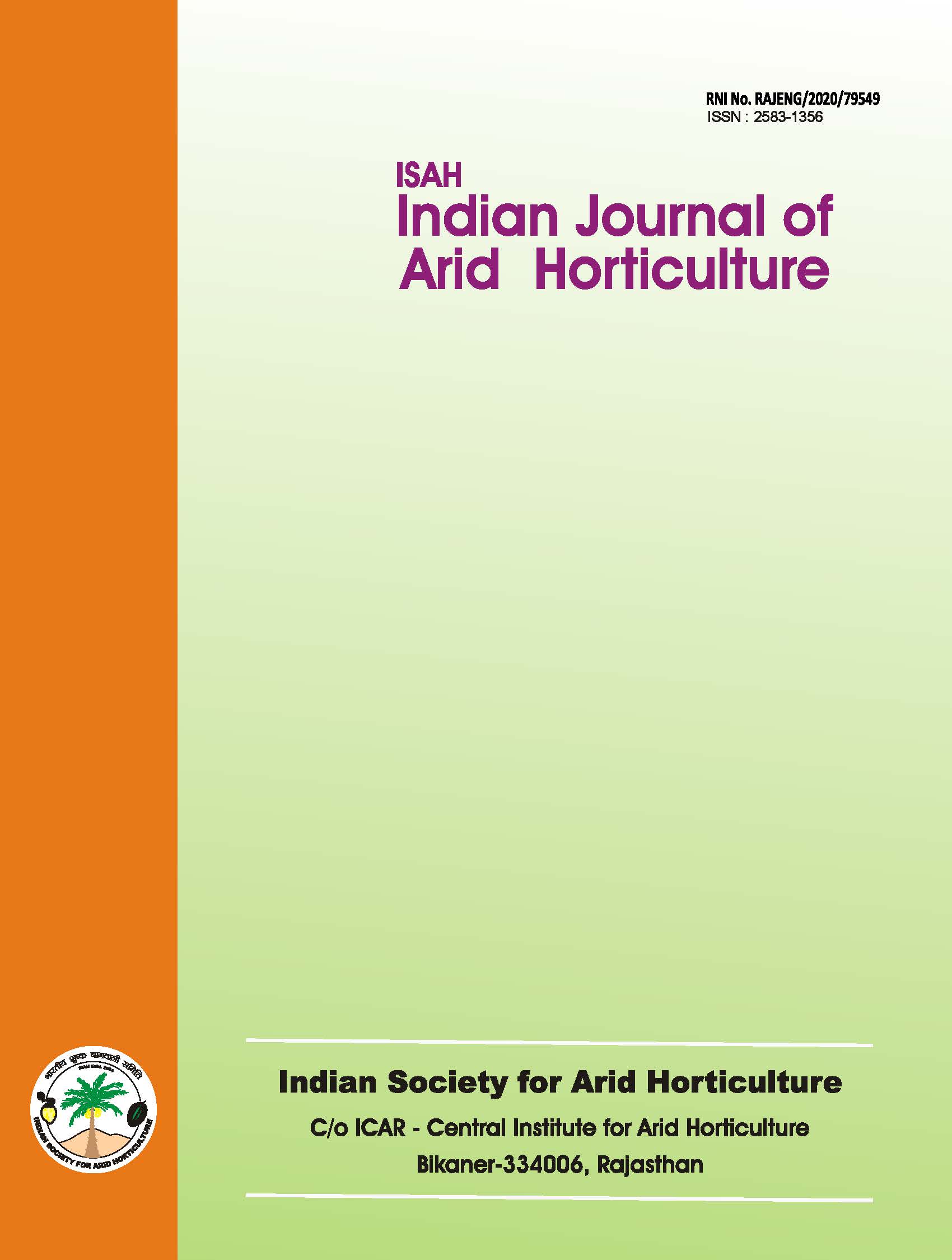Influence of weather parameters on the seasonal incidence of chilli thrips, Scirtothrips dorsalis Hood
Keywords:
Chilli, Scirtothrips dorsalis, seasonal incidence, weather parametersAbstract
The field experiment was conducted during Kharif 2014 on seasonal incidence of chilli thrips (Scirtothrips dorsalis Hood) and its natural enemies. The results revealed that the higher population of thrips and coccinillids was recorded in the range of 11.27 to 14.93 thrips per 6 leaves per plant and 0.40 to 0.53 coccinillids per plant, respectively during 2nd week of October to 1" week of November. However, peak activity of thrips (14.93 per 6 leaves per plant) and cocinillids (0.53 per plant) was observed during the 4* week of October (44" MW) and 1 week of November (45" MW). Then gradually declined in population up to last week of December (52 MW). All the weather parameters i.e. temperatures (maximum and minimum), relative humidity (morning and evening) and rainfall were correlated negatively with the incidence of thrips population and abundance of coccinellids except maximum temperature showed positive correlation with coccinellids.Downloads
References
Ahmed, K., Mohamad, M. G. and Murthy, N. S. R. 1987. Yield losses due to various pests in hot pepper. Capsicum Newsletter, 6:83-84.
Barot, B. V., Patel, J. J. and Shaik, A. A. 2012. Population dynamics of chilli thrips, Scirtothrips dorsalis Hood in relation to weather parameter. AGRES- An International e-Journal, 1(4): 480-485. Bhede, B. V., Suryawanshi, D. S. and More, D. G. 2008. The
studies on population dynamics and bioefficacy of newer insecticide against chilli thrips, Scirtothrips dorsalis (Hood). Indian Journal of Entomology, 70 (3):223-226.
Day, P. K., Sarkar, P. K. and Somachoudhary, A. K. 2001. Efficacy of different treatment schedule of profenophos against major pest of chilli. Pestology, 25(11):26-29.
Hosamani, A. 2006. Incidence of thrips and mites in chilli
Ph.D. (Agri.) thesis submitted to University of Agriculture Sciences, Dharwad: pp. 45-46. Kandaswamy, C., Mohanasundaram, M. and Karuppuchamy,
P. 1990. Evaluation of insecticides for the control of the thrips, Scirtothrips dorsalis Hood on chillies (Capsicum annuum L.). Madras Agricultural Journal, 77 (3-4): 169-172.
Meena, R. S., Ameta, O. P. and Meena, B. L. 2013. Population dynamics of sucking pest and their correlation with weather parameters in chilli, Capsiccum annuum L. crop. The Bioscan, 8(1): 177-180.
Meena, N. K., and Kanwat P. M. 2010. Studies on seasonal incidance and relative safety of pesticides against coccinellid beetles in okra ecosystem. Journal of Biological Control, 24: 116-122.
Ningappa, M. S. 1972. Studies on the role of Scirtothrips dorsalis Hood (Thysanoptera Thripidae) and Polyphagotarsonemus latus (Banks) (Acarina: Tarsonemidae) in causing leaf curl and their control. M.Sc. (Agri.) thesis submitted to University of Agricultural Sciences, Bangalore: p.
64.
Patel, B. H., Koshiya, D. J. and Korat, D. M. 2009. Population dynamics of chilli thrips, Scirtothrips dorsalis Hood in relation to weather parameters. Karnataka Journal of Agricultural Sciences, 22 (1): 108-110. Pathipati, V. L., Vijayalakshmi, T. and Naramnaidu, L. 2014. Seasonal incidence of major pest of chilli in relation to weather parameters in Andhra Pradesh. Pest Management in Horticultural Ecosystems, 20(1): 36-40.
Raizada, U. 1965. The life history of Scirtothrips dorsalis Hood with detail external morphology of its immature stages. Bulletin of Entomological Research, 6:30-49.

